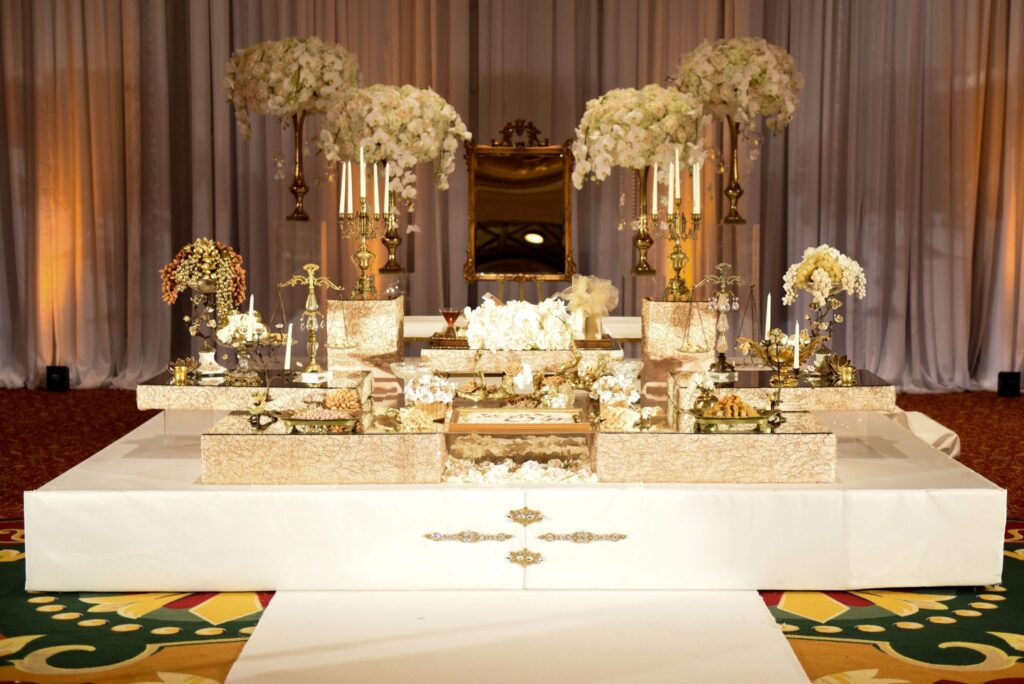Sofreh Aghd
Traditional Persian Ceremony Elements
Perhaps the most important element of a traditional Persian ceremony, the Sofreh Aghd represents elements and blessings for the couple’s new life together. Like many, the Iranians have diverse religious backgrounds but being a cultural ceremony element, the Sofreh Aghd is used regardless of religion and accompanied by the Mokhaddeh (the bride and groom’s seating).
Ayeeneh
Quite easily the most prominent element of the Sofreh Aghd, the mirror sits at the head of the wedding table and stays with the couple throughout their marriage and put on display in their home. The Ayeeneh is reflective, quite literally, of light and a representation for a bright future. It is customary for a bride to enter the room veiled and for the groom’s first look to be a reflection of her in the mirror. One of the most iconic moments we capture is of the newlyweds looking into the mirror as a representation of looking toward their future together.
Shamdoon
Zoroastrianism is by far one of the biggest influences in Persian celebrations. Whether it is Nowruz or Aroosi, most traditional Persian celebrations center around fire. Within the culture, fire is not seen as destructive but as a purifying agent. The Shamdoon (candles and candelabras) signify purity, the fire symbolizing energy and clarity of mind during the couple’s life together.
Holy Book of Choice
Signifying both the importance of prayer and blessing in the couple’s life, the Holy Book represents an energy of love and lifelong blessing from God. As one of the most prominent symbols of harmony, the Holy Book can embody multiple traditions and heritages. If the couple prefers to not use religious texts, it is highly suggested to use Hafez Book of Poetry which has been stated to be the highest literary symbol of love in Persian culture.
Noone Sangak & Meevah
Noone Sangak, a flatbread native to Iran and baked using hot stones, is included as a symbol of prosperity and feasts for the future. Traditionally intended to be shared with the guests it reinforces the importance of familial relationships in the Persian culture. Although the bread can be simple, we’ve seen the Noone Sangak ornately arranged, either shaped like flowers or with the word Mobarak (celebrate or celebrations) etched into it. The Meevah (basket of fruit) represents a joyous future with seasonal fruit, most notably anar (pomegranates) or seeb (apples).
Tokhmeh Morgh
Tokhmeh Morgh represents fertility and are ornately decorated eggs either beaded or painted gold. Typically the eggs are accompanied by badoom, gandom, and gerdoo – almonds, walnuts, and hazelnut, painted or dipped gold and strung together.
Asal
Throughout a traditional Persian wedding ceremony, sweet items incorporated in the Sofreh Aghd symbolize the sweetness of the union and blessings for a sweet life. As part of the ceremony, the couple feeds each other asal (honey) which represents the continual sweetness and love they will give each other throughout their marriage.
Sheereeni & Shahkh-eh-Nabaat
Sheereeni (pastries) are displayed and shared with the guests. Among the sweets, the Shahkh-eh-Nabaat (a rock candy bowl) is kept as a keepsake for the couple.
Kaleh Ghand
As the couple sits on the mokhaddeh the Torreh ghand (sugar cloth) is extended over them. Happily married members of their family take turns grinding sugar cones together; these happily, marries guests use the Kaleh Ghand to shower the bride and groom with sweetness and pass on a blessing from one generation to the next.
Esfand
A very important element in a traditional Persian ceremony, the burning of incense wards away the “evil eye”. To further combat any negativity or malice intent, another woman precedes the bride as she walks down the aisle burning Esfand (wild rue). As she takes her seat on the mokhaddeh, the incense is set on the Sofreh Aghd to drive away all negativity from the sweet union.
Khoncheh
One of the most well-designed parts of the table, the Khoncheh is an assortment of seven herbs and spices in seven different colors representing prosperity and spiciness of life. Compiled in this assortment are: poppy seeds (khash-khaash), wild rice (berenj), angelica (sabzi khoshk), salt (namak), nigella seeds (raziyaneh), black tea (chai) and frankincense (kondor). Each of the spices has a specific meaning and significance, however, generally, they are used to ward against evil spirits.
Golab
Rose water is a perfect example of the immense history and culture surrounding a traditional Persian wedding ceremony. With its distinct taste, fragrance, and influence in Iran, Golab (rose water) is the perfect fragrance to accompany the Sofreh Aghd.
Sekkeh
Sekkeh (gold coins) or Tala (gold) is placed on the Sofreh spread to represent wealth and prosperity for the couple.
Soozan Nakh
The Soozan Nakh (needle and thread) symbolizes the blending of two families becoming one.

